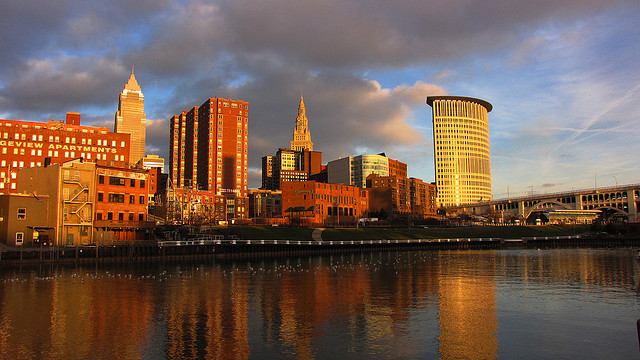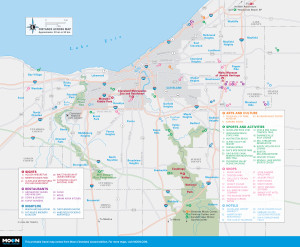
The Flats, Cleveland. Photo © Christina Spicuzza, licensed Creative Commons Attribution.
There’s a level of enthusiasm and optimism in Cleveland, the likes of which hasn’t been felt in decades. Population in the city center has more than doubled in the past 10 years, introducing an abundance of fresh energy to downtown streets. Many of those new residents are young professionals, who bring with them all the positive trappings of a modern generation. Look around today and you’ll see more bikes, breweries, food trucks, urban gardens, creative start-ups, and a slower pace to the day. Major film studios have recently discovered that Cleveland’s grand 20th-century architecture makes a fine backdrop to just about any story.Those outside the region are taking notice, too. Major film studios have recently discovered that Cleveland’s grand 20th-century architecture makes a fine backdrop to just about any story. The dining scene continues to attract more than its fair share of attention, creating a boom in food-related tourism. And more than $2 billion worth of recent development has doubled the number of annual visitors, who beat a path to Cleveland’s world-class museums and stages.But more than anything, there is a genuine sense of civic pride. After decades of serving as the nation’s favorite punch line, Cleveland finally seems to have shaken off the rust, put its house in order, and emerged as a contemporary city with solid Midwestern roots. Rather than wait for others to label and define their town, locals simply are appreciating the affordability, accessibility, and beauty of this city on a Great Lake.
These days, it seems you can’t pick up a magazine or newspaper without reading another story about Cleveland’s “Rust Belt Revival.” Around here, folks just call that Tuesday.

Greater Cleveland
Roughly equidistant from Chicago and New York City, Cleveland is described as the point where the East Coast meets the Midwest. The city is close enough to the heartland to reap the hospitable sensibilities of that region—hence the saying: “Winters here may be harsh, but never the people.” Quick jaunts to the Big Apple are easy as pie, creating locally a demand for the same products, fashions, restaurants, and nightlife enjoyed out of town. Cleveland’s best-of-both-worlds situation translates to hurried commuters, dressed to the nines, stopping to point a misguided soul in the right direction.
If any word accurately describes the people of Greater Cleveland, it is diverse. After the initial settling of transplanted British colonists, Cleveland enjoyed numerous waves of ethnic-specific immigration. By the late 1800s, a full 10 percent of the population was Irish. Most lived in Ohio City and worked at the docks unloading cargo. A comparatively larger contingent of German immigrants followed, some coming from as near as Pennsylvania, others straight from the motherland. Other significant migrations included large contingents of Italians, Russians, Jews, Slovenians, Slovakians, Poles, Hungarians, and Ukrainians. Much later, the city welcomed Asian immigrants, specifically Chinese, Korean, and Vietnamese, but also Thai, Laotian, and Indian. Hispanics came in equally impressive numbers too. Walk into the West Side Market on a busy Saturday morning and you might be able to pick out a dozen different languages.
Cleveland’s present-day population is just under a half million, down about 8 percent from the late 1990s. The city suffered its biggest losses in the 1970s, when almost 25 percent of its residents fled town, many simply relocating to suburban environs. Today, the five-county Greater Cleveland area contains well over two million people, making it one of the most densely populated regions in the country.
There are signs that this outward migration may slow, even reverse, in the coming years. Massive new investment in University Circle-area hospitals, spurred by a surging knowledge economy, coupled with a mini-boom of downtown housing projects, show promise in stemming the tide.
Excerpted from the Second Edition of Moon Cleveland.